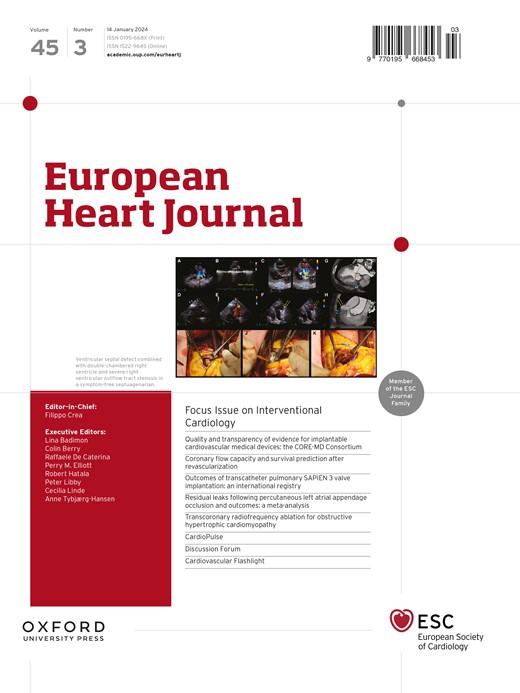Coronary artery bypass grafting with or without preoperative physiological stenosis assessment: a SWEDEHEART study.
IF 37.6
1区 医学
Q1 CARDIAC & CARDIOVASCULAR SYSTEMS
引用次数: 0
Abstract
BACKGROUND AND AIMS Physiological flow assessment of coronary stenoses, such as fractional flow reserve, are routinely used to guide percutaneous coronary intervention, but it has not been equally recognized to guide coronary artery bypass grafting (CABG). Mid-term outcomes in CABG patients with and without preoperative flow assessment were compared. METHODS All patients with first-time isolated CABG in Sweden 2013-2020 were identified in the SWEDEHEART registry (n = 18 211), which also provided information on flow assessment. Data were linked with three mandatory national registries. Median follow-up was 3.6 years (range 0-7.5). Incidence of all-cause mortality, stroke, new myocardial infarction, new coronary angiography, and new revascularization was compared using adjusted Cox regression models. The proportional hazard assumption was violated for new angiography and revascularization. Hence, follow-up was divided into 0-2 and >2 years. RESULTS Overall, 2869 patients (15.8%) had flow assessment before surgery, increasing from 7.1% in 2013% to 21.5% in 2020. Patients with flow assessment were younger, had a lower EuroSCORE II, and received fewer distal anastomoses (3.0 ± 0.9 vs 3.2 ± 1, P < .001). There were no associations between flow assessment and mortality, post-discharge myocardial infarction, or stroke. New angiography and new revascularization were not significantly different 0-2 years, but preoperative flow assessment was associated with a higher risk for new angiography [adjusted hazard ratio (aHR) 1.32, 95% confidence interval (CI) 1.08-1.62, P = .008] and new revascularization (aHR 1.55, 95% CI 1.18-2.04, P = .002) >2 years after CABG. CONCLUSIONS Preoperative flow assessment was not associated with improved clinical outcomes but with a higher risk for new angiography and new revascularization >2 years after CABG. The results suggest that the use of flow assessment with current cut-off levels may not be applicable in CABG, and further studies are needed.有或没有术前生理狭窄评估的冠状动脉旁路移植术:一项SWEDEHEART研究。
背景和目的冠状动脉狭窄的生理血流评估,如血流储备分数,通常用于指导经皮冠状动脉介入治疗,但尚未被同等认可用于指导冠状动脉旁路移植术(CABG)。比较有术前血流评估和没有术前血流评估的CABG患者的中期结果。方法2013-2020年瑞典所有首次孤立性冠状动脉搭桥患者均在SWEDEHEART注册中心(n = 18 211)中确定,该注册中心也提供了血流评估信息。数据与三个强制性国家登记处联系在一起。中位随访时间为3.6年(0-7.5年)。采用校正Cox回归模型比较全因死亡率、卒中、新发心肌梗死、新发冠状动脉造影和新发血运重建术的发生率。新的血管造影和血运重建术违反了比例风险假设。因此,随访期分为0 ~ 2年和0 ~ 2年。结果术前流量评估2869例(15.8%),由2013年的7.1%上升至2020年的21.5%。进行血流评估的患者年龄较小,EuroSCORE II较低,远端吻合术较少(3.0±0.9 vs 3.2±1,P < .001)。血流评估与死亡率、出院后心肌梗死或中风之间没有关联。新血管造影和新血运重建0-2年无显著差异,但术前血流评估与冠脉搭桥后2年新血管造影和新血运重建(aHR 1.55, 95% CI 1.18-2.04, P = 0.008)的风险较高相关。结论术前血流评估与改善临床结果无关,但与冠状动脉搭桥术后2年新血管造影和新血运重建术的风险增加有关。结果表明,使用当前截止水平的流量评估可能不适用于CABG,需要进一步研究。
本文章由计算机程序翻译,如有差异,请以英文原文为准。
求助全文
约1分钟内获得全文
求助全文
来源期刊

European Heart Journal
医学-心血管系统
CiteScore
39.30
自引率
6.90%
发文量
3942
审稿时长
1 months
期刊介绍:
The European Heart Journal is a renowned international journal that focuses on cardiovascular medicine. It is published weekly and is the official journal of the European Society of Cardiology. This peer-reviewed journal is committed to publishing high-quality clinical and scientific material pertaining to all aspects of cardiovascular medicine. It covers a diverse range of topics including research findings, technical evaluations, and reviews. Moreover, the journal serves as a platform for the exchange of information and discussions on various aspects of cardiovascular medicine, including educational matters.
In addition to original papers on cardiovascular medicine and surgery, the European Heart Journal also presents reviews, clinical perspectives, ESC Guidelines, and editorial articles that highlight recent advancements in cardiology. Additionally, the journal actively encourages readers to share their thoughts and opinions through correspondence.
 求助内容:
求助内容: 应助结果提醒方式:
应助结果提醒方式:


